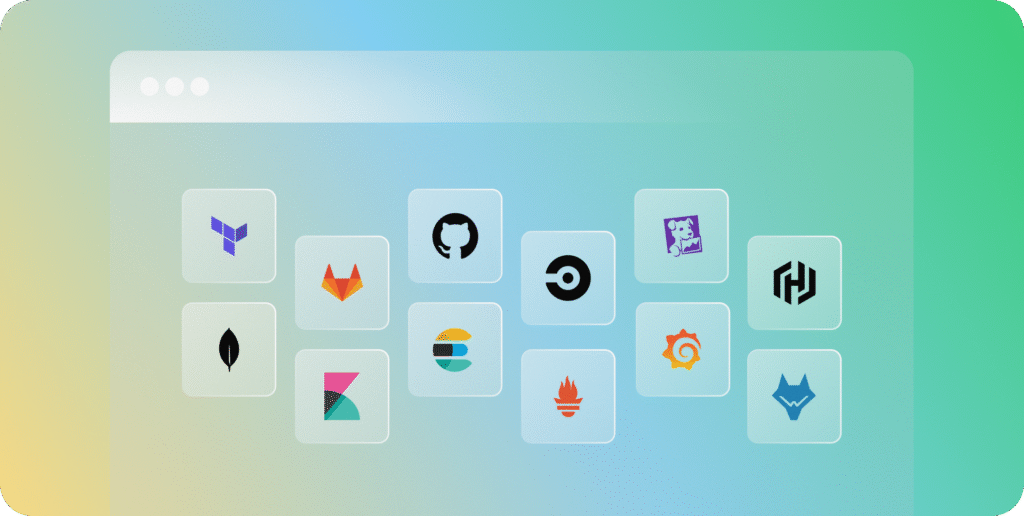Having the right DevOps stack for your organization and technical needs is crucial, whether you’re a startup or an enterprise in a regulated industry.
Developers, product managers (PMs), CIOs, and CTOs are spoiled for choice when it comes to tools for their tech stack.
The challenge is finding the right ones for your technical and operational needs, and making sure they all fit and work well together.
Key Takeaways
- Overly complex DevOps stacks cause more problems than they solve.
- Every DevOps stack needs certain categories of tools, like version control, CI/CD, IaC, container orchestration, runtime, configuration management, monitoring, observability, security, and compliance.
- You need to pick the right tools for your DevOps stack, and only the right tools, and that’s where it can get difficult.
DevOps Stack Tech Challenges
The DevOps market has thousands of tools. This creates both opportunity and confusion. DevOps is a simple idea that brings together development and operations. Yet it has evolved into a complex ecosystem of platforms, frameworks, and AI-powered solutions.
Too many DevOps teams have more tools and software solutions than they need, causing tool bloat. This includes SaaS, PaaS, and IaaS. Collecting solutions without a clear integration strategy creates chaos.
Tech stack bloat leads to fragmented workflows, increased costs, and frustrated developers. A better goal is building a streamlined, efficient, and scalable DevOps toolchain. This should solve problems without creating new ones.
Picking the right DevOps tech stack isn’t easy. DevOps tools come in so many formats, and in some cases, it comes down to what developers prefer to have in their stack. However, personal preference can’t be the only way to choose. Continuous delivery relies on deployment software that a DevOps team can use for effective software delivery.
For teams wanting pre-integrated, low-code DevOps solutions, platforms like DuploCloud offer a smart approach that simplifies and streamlines any DevOps stack.
7 Core Tech Categories in a DevOps Stack
1. Version Control
Git remains the foundation of modern DevOps for version control. GitHub, GitLab, and Bitbucket are the leading platforms.
These popular, powerful, AI-powered platforms do more than store code. They operate as a central hub for collaboration, documentation, and automation code development.
GitOps is an increasingly popular part of DevOps. Infrastructure and application deployments are managed through Git workflows. This makes your Git repository the single source of truth. Changes are automatically deployed when code is merged.
With the right DevOps tools integrated with GitOps, you can use the same review processes and audit trails for application code and infrastructure management
2. CI/CD pipelines
Continuous integration and deployment pipelines automate the journey from code commit to production.
Popular solutions include Jenkins, GitHub Actions, GitLab CI, CircleCI, and ArgoCD. Most teams pick something that balances flexibility, speed, and policy integration.
Modern CI/CD systems need to handle complex workflows, integrate with security scanning tools, and support different deployment strategies. DuploCloud provides built-in CI/CD automation out of the box, reducing setup time for teams that want to focus on building features rather than pipelines.
3. Infrastructure as Code (IaC)
Infrastructure as Code (IaC) is a powerful leap forward for DevOps. Tools like Terraform, Pulumi, and AWS CloudFormation help you define infrastructure using code. This brings version control and repeatability to your cloud resources.
IaC serves as the backbone for compliance and disaster recovery, ensuring your infrastructure can be rebuilt consistently. The key benefit is treating infrastructure with the same rigor as application code.
Changes go through review processes, deployments are repeatable, and rollbacks are now possible. DuploCloud supports Terraform while abstracting much of the complexity for faster delivery.
4. Container orchestration and runtime
Kubernetes has become the standard for container orchestration. Docker remains the most common runtime solution. Helm simplifies package management for Kubernetes applications. Orchestration makes it all possible.
These platforms need strong observability, autoscaling capabilities, and policy controls. The learning curve is steep. But the benefits of standardized deployment patterns and resource management make the investment worthwhile for most teams.
If you have a stack engineer or operations teams, they might have more say over the DevOps process and tools picked for infrastructure management.
5. Configuration Management
Configuration management still plays an important role in DevOps. However, it plays a smaller role with Infrastructure as Code. Developers tend to prefer IaC, as it aligns more easily with DevOps principles for DevOps teams immersed in the norms of cloud computing infrastructure management.
Tools like Ansible, Chef, and Puppet once dominated configuration management. But in containerized environments, they mainly stay relevant for managing virtual machines, legacy systems, and hybrid infrastructure when containers aren’t possible.
Immutable infrastructure is the trend. Servers are replaced rather than updated. This reduces the need for traditional configuration management tools.
6. Monitoring and observability
Monitoring and observability are a crucial part of modern DevOps. DuploCloud’s advanced observability solutions integrate OpenTelemetry, Prometheus, and Grafana by default, reducing setup complexity.
Prometheus and Grafana form a popular open-source monitoring stack. Commercial options include Datadog and New Relic, and these provide integrated solutions. As required, Loki could add log aggregation to complete the observability picture.
Effective monitoring goes beyond basic metrics. DevOps teams need real-time alerts, service level objectives (SLOs), and AI-powered dashboards that identify issues before they become full-blown problems.
7. Security and compliance software
Security and compliance must be built into every layer of your DevOps stack.
For example, Open Policy Agent can enforce policies across your infrastructure. HashiCorp Vault can manage infrastructure security. Tools like Snyk and Aqua Security scan for vulnerabilities.
With a shift-left approach, you benefit from security earlier in the development process. This happens through automated scanning, image signing, and policy enforcement. DuploCloud automates compliance enforcement for SOC 2, PCI, HIPAA, and many other frameworks.
Now, let’s look at how to choose the most suitable DevOps stack. This includes examples based on team size and type of company.
How to Choose the Right DevOps Stack for Your Team
Selecting tools requires an honest assessment of your DevOps maturity, budget, operating processes, and team skillset. A five-person startup has different needs than a 500-person enterprise.
Focus on integration possibilities and reducing handoffs between tools. Prioritize automation and compliance readiness from the start.
Tools that seem simple initially often create technical debt when your needs grow. Consider using the total cost of ownership, not just the subscription cost. This includes the cost of implementing, time to value, and ongoing maintenance.
DuploCloud reduces DevOps ramp-up time through pre-integrated tooling. This lets teams focus on business value rather than infrastructure complexity.
Need help configuring or picking the right DevOps stack software? Get a DuploCloud Demo today.
DevOps Stack Examples by Team Type & Company Size
Naturally, the configuration of your tech stack should be influenced by your constraints and needs. Larger organizations need more complex and robust DevOps stacks. Smaller teams, like startups, need simpler, more agile DevOps toolkits.
Constraints and needs are also impacted by budgets, operational goals, and where you sit on the DevOps maturity curve.
- Early-stage Startup: GitHub + GitHub Actions + Terraform + Docker + lightweight Kubernetes (k3s).
Focus on simplicity, speed, and cost control. DuploCloud works well for startups needing full DevOps capabilities without hiring dedicated DevOps engineers.
- Mid-market SaaS: GitLab + GitLab CI + Terraform + Kubernetes + Prometheus/Grafana + Vault.
At this stage, there’s a stronger emphasis on compliance, security, and scalability as a business grows. Or for businesses that have been mid-market for many years and need to upgrade their DevOps stack.
- Enterprise in a regulated industry: Jenkins + ArgoCD + Terraform + OPA + HashiCorp Vault + cloud-native tools.
The DevOps stack must support auditability, role-based access control, and segregation of duties. Fortunately, DuploCloud is equipped to support strict regulatory compliance requirements for regulated enterprise-sized organizations.
Common DevOps Stack Pitfalls to Avoid
Tool overload without an integration strategy creates more problems than it solves. DIY pipelines often become fragile and difficult to scale as teams grow. Security built on as an afterthought costs more to fix than building it in from the beginning.
Knowledge silos and poor documentation turn your DevOps stack into a black box that only a few team members understand. Compliance treated as an afterthought creates expensive retrofitting later.
Key Takeaways: Build for Scale, Automate for Speed
A great DevOps stack balances flexibility, automation, and governance. Choose tools that grow with your team rather than requiring replacement as you scale. Build platforms that enable your developers to ship faster and more reliably.
The goal isn’t having the most tools or the newest technology. Even AI shouldn’t just be thrown into the mix without knowing the role it will play. A powerful DevOps stack is a system that reduces friction, increases reliability, and lets your team focus on delivering value to customers.
Whether you build your stack piece by piece or use an integrated platform like DuploCloud, the key is starting with a clear strategy and evolving thoughtfully as your needs change.
Need help configuring or picking the right DevOps stack software? Get a DuploCloud Demo today.



